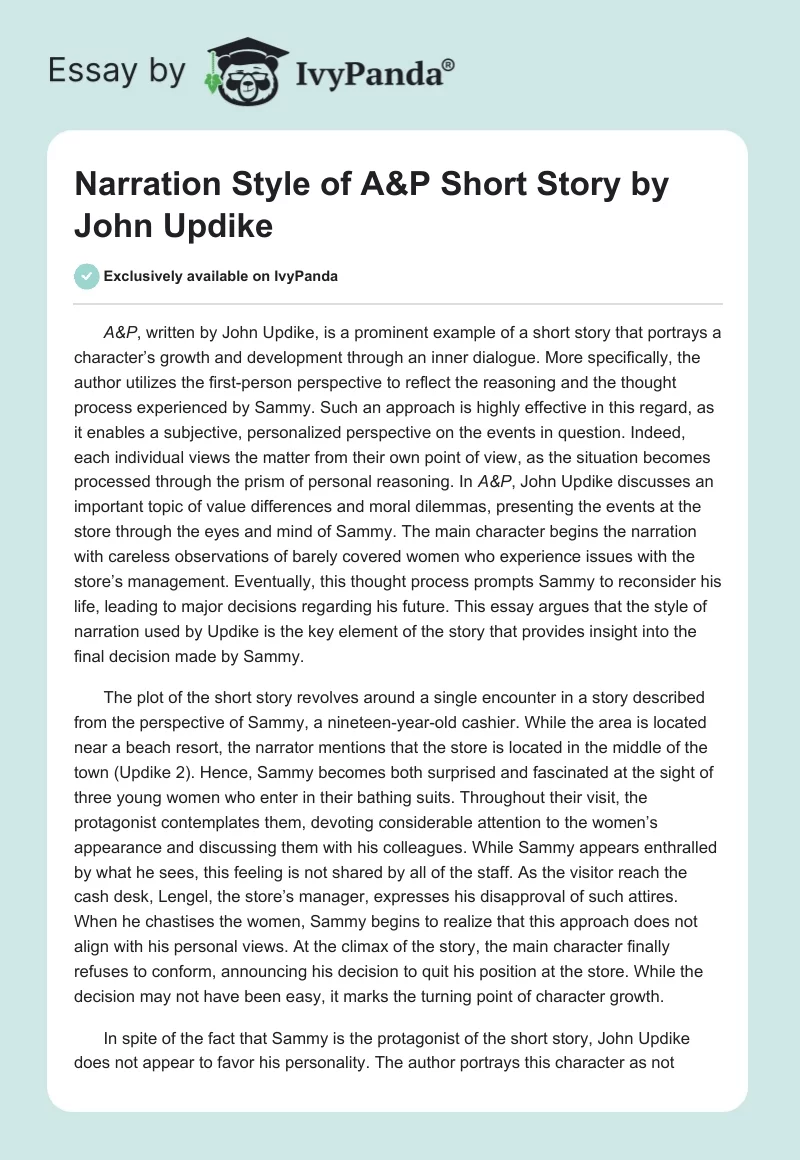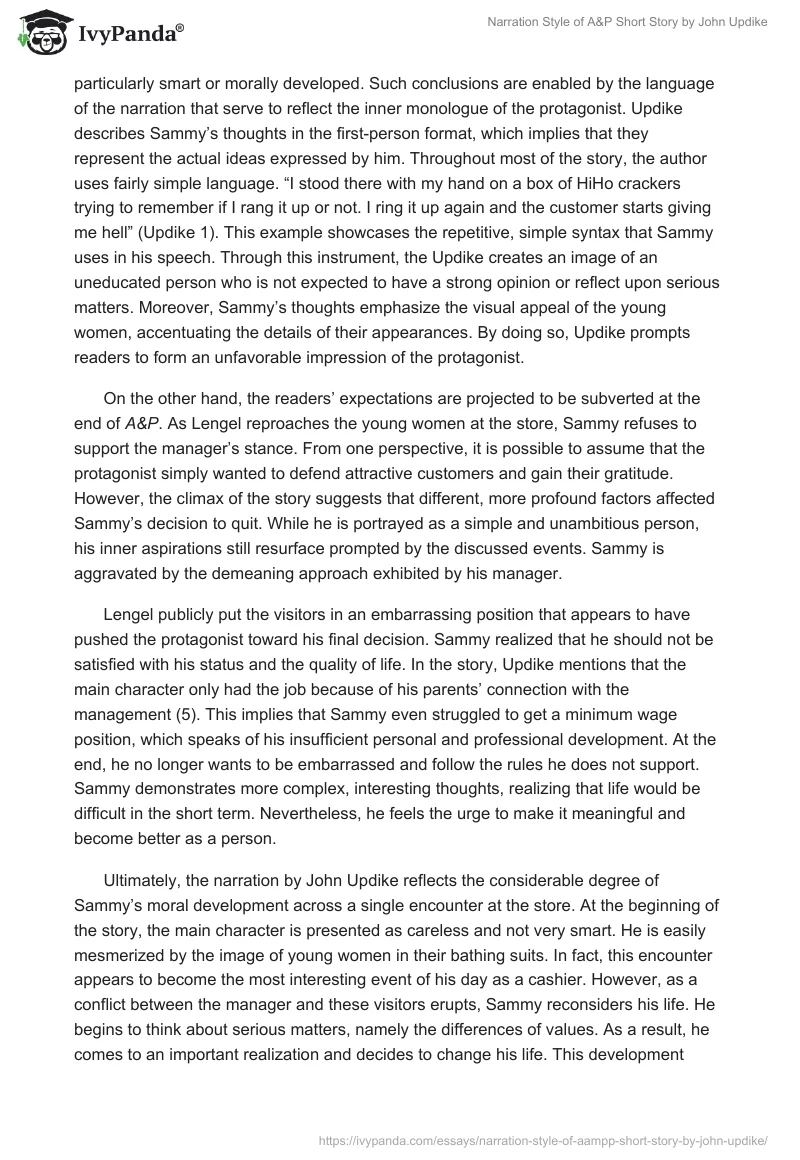A&P, written by John Updike, is a prominent example of a short story that portrays a character’s growth and development through an inner dialogue. More specifically, the author utilizes the first-person perspective to reflect the reasoning and the thought process experienced by Sammy. Such an approach is highly effective in this regard, as it enables a subjective, personalized perspective on the events in question. Indeed, each individual views the matter from their own point of view, as the situation becomes processed through the prism of personal reasoning. In A&P, John Updike discusses an important topic of value differences and moral dilemmas, presenting the events at the store through the eyes and mind of Sammy. The main character begins the narration with careless observations of barely covered women who experience issues with the store’s management. Eventually, this thought process prompts Sammy to reconsider his life, leading to major decisions regarding his future. This essay argues that the style of narration used by Updike is the key element of the story that provides insight into the final decision made by Sammy.
The plot of the short story revolves around a single encounter in a story described from the perspective of Sammy, a nineteen-year-old cashier. While the area is located near a beach resort, the narrator mentions that the store is located in the middle of the town (Updike 2). Hence, Sammy becomes both surprised and fascinated at the sight of three young women who enter in their bathing suits. Throughout their visit, the protagonist contemplates them, devoting considerable attention to the women’s appearance and discussing them with his colleagues. While Sammy appears enthralled by what he sees, this feeling is not shared by all of the staff. As the visitor reach the cash desk, Lengel, the store’s manager, expresses his disapproval of such attires. When he chastises the women, Sammy begins to realize that this approach does not align with his personal views. At the climax of the story, the main character finally refuses to conform, announcing his decision to quit his position at the store. While the decision may not have been easy, it marks the turning point of character growth.
In spite of the fact that Sammy is the protagonist of the short story, John Updike does not appear to favor his personality. The author portrays this character as not particularly smart or morally developed. Such conclusions are enabled by the language of the narration that serve to reflect the inner monologue of the protagonist. Updike describes Sammy’s thoughts in the first-person format, which implies that they represent the actual ideas expressed by him. Throughout most of the story, the author uses fairly simple language. “I stood there with my hand on a box of HiHo crackers trying to remember if I rang it up or not. I ring it up again and the customer starts giving me hell” (Updike 1). This example showcases the repetitive, simple syntax that Sammy uses in his speech. Through this instrument, the Updike creates an image of an uneducated person who is not expected to have a strong opinion or reflect upon serious matters. Moreover, Sammy’s thoughts emphasize the visual appeal of the young women, accentuating the details of their appearances. By doing so, Updike prompts readers to form an unfavorable impression of the protagonist.
On the other hand, the readers’ expectations are projected to be subverted at the end of A&P. As Lengel reproaches the young women at the store, Sammy refuses to support the manager’s stance. From one perspective, it is possible to assume that the protagonist simply wanted to defend attractive customers and gain their gratitude. However, the climax of the story suggests that different, more profound factors affected Sammy’s decision to quit. While he is portrayed as a simple and unambitious person, his inner aspirations still resurface prompted by the discussed events. Sammy is aggravated by the demeaning approach exhibited by his manager.
Lengel publicly put the visitors in an embarrassing position that appears to have pushed the protagonist toward his final decision. Sammy realized that he should not be satisfied with his status and the quality of life. In the story, Updike mentions that the main character only had the job because of his parents’ connection with the management (5). This implies that Sammy even struggled to get a minimum wage position, which speaks of his insufficient personal and professional development. At the end, he no longer wants to be embarrassed and follow the rules he does not support. Sammy demonstrates more complex, interesting thoughts, realizing that life would be difficult in the short term. Nevertheless, he feels the urge to make it meaningful and become better as a person.
Ultimately, the narration by John Updike reflects the considerable degree of Sammy’s moral development across a single encounter at the store. At the beginning of the story, the main character is presented as careless and not very smart. He is easily mesmerized by the image of young women in their bathing suits. In fact, this encounter appears to become the most interesting event of his day as a cashier. However, as a conflict between the manager and these visitors erupts, Sammy reconsiders his life. He begins to think about serious matters, namely the differences of values. As a result, he comes to an important realization and decides to change his life. This development becomes clear through the first-person perspective that enables a better understanding of the character’s value paradigm and its growth. Overall, the author’s choice of the narration style becomes the essential enabler of the story’s profound impact on the reader.


